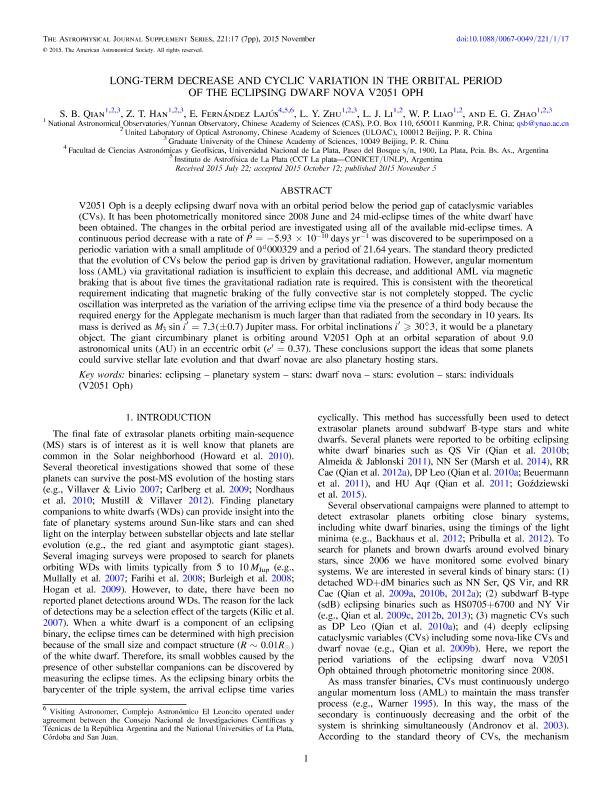Artículo
Long-term decrease and cyclic variation in the orbital period of the eclipsing dwarf nova V2051 Oph
Qian, S. B. ; Han, Z. T. ; Fernandez Lajus, Eduardo Eusebio ; Zhu, L. Y. ; Li, L. J.; Liao, W. P. ; Zhao, E. G.
; Zhu, L. Y. ; Li, L. J.; Liao, W. P. ; Zhao, E. G.
 ; Zhu, L. Y. ; Li, L. J.; Liao, W. P. ; Zhao, E. G.
; Zhu, L. Y. ; Li, L. J.; Liao, W. P. ; Zhao, E. G.
Fecha de publicación:
11/2015
Editorial:
Iop Publishing
Revista:
Astrophysical Journal Supplement Series
ISSN:
0067-0049
Idioma:
Inglés
Tipo de recurso:
Artículo publicado
Clasificación temática:
Resumen
V2051 Oph is a deeply eclipsing dwarf nova with an orbital period below the period gap of cataclysmic variables (CVs). It has been photometrically monitored since 2008 June and 24 mid-eclipse times of the white dwarf have been obtained. The changes in the orbital period are investigated using all of the available mid-eclipse times. A continuous period decrease with a rate of dP/dt = -5.93x10^(-10) days/yr was discovered to be superimposed on a periodic variation with a small amplitude of 0 000329 and a period of 21.64 years. The standard theory predicted that the evolution of CVs below the period gap is driven by gravitational radiation. However, angular momentum loss (AML) via gravitational radiation is insufficient to explain this decrease, and additional AML via magnetic braking that is about five times the gravitational radiation rate is required. This is consistent with the theoretical requirement indicating that magnetic braking of the fully convective star is not completely stopped. The cyclic oscillation was interpreted as the variation of the arriving eclipse time via the presence of a third body because the required energy for the Applegate mechanism is much larger than that radiated from the secondary in 10 years. Its mass is derived as M3 sin i´ = 7.3 (+-0.7) Jupiter mass. For orbital inclinations i >= 30º.3, it would be a planetary object. The giant circumbinary planet is orbiting around V2051 Oph at an orbital separation of about 9.0 astronomical units (AU) in an eccentric orbit (e′ = 0.37). These conclusions support the ideas that some planets could survive stellar late evolution and that dwarf novae are also planetary hosting stars.
Archivos asociados
Licencia
Identificadores
Colecciones
Articulos(IALP)
Articulos de INST.DE ASTROFISICA LA PLATA
Articulos de INST.DE ASTROFISICA LA PLATA
Citación
Qian, S. B. ; Han, Z. T. ; Fernandez Lajus, Eduardo Eusebio; Zhu, L. Y. ; Li, L. J.; et al.; Long-term decrease and cyclic variation in the orbital period of the eclipsing dwarf nova V2051 Oph; Iop Publishing; Astrophysical Journal Supplement Series; 221; 17; 11-2015; 1-7
Compartir
Altmétricas



